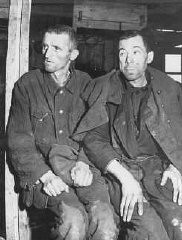You searched for: 奢侈品商城项目搭建【TG���������@EK7676】平台包网搭建奢侈品商城项目搭建【TG���������@EK7676】平台包网搭建29WSEOg1bc
<< Previous | Displaying results 26-50 of 183 for "奢侈品商城项目搭建【TG���������@EK7676】平台包网搭建奢侈品商城项目搭建【TG���������@EK7676】平台包网搭建29WSEOg1bc" | Next >>
-
The 42nd Infantry Division during World War II
ArticleThe 42nd Infantry Division participated in major WWII campaigns and is recognized for liberating the Dachau concentration camp in 1945.
-
Dachau - Photographs
Media EssayDachau opened in Germany in March 1933. It was the first regular concentration camp of the Nazi regime. Prisoners were subjected to horrific conditions, forced labor, and medical experiments. Dachau became the model for all Nazi concentration camp...
-
Dachau - ID Card/Oral History
Media EssayPrisoners of the Dachau concentration camp were subjected to horrific conditions, forced labor, and medical experiments. The camp was liberated by American forces on April 29, 1945.Here, Dachau survivors and US Army veterans share their tes...
-
Dachau - Historical Film Footage
Media EssayDachau opened in Germany in March 1933. It was the first regular concentration camp of the Nazi regime. Prisoners were subjected to horrific conditions, forced labor, and medical experiments. Dachau became the model for all other Nazi concentratio...
-
Dachau (Abridged Article) - Photograph
Media EssayDachau opened in Germany in March 1933. It was the first regular concentration camp of the Nazi regime. Prisoners were subjected to horrific conditions, forced labor, and medical experiments. Dachau became the model f...
-
Dachau (Abridged Article) - ID Card/Oral History
Media EssayPrisoners of the Dachau concentration camp were subjected to horrific conditions, forced labor, and medical experiments. The camp was liberated by American forces on April 29, 1945. Here, Dachau surviviors and US Army veterans share th...
-
Dachau (Abridged Article) - Historical Film Footage
Media EssayDachau opened in Germany in March 1933. It was the first regular concentration camp of the Nazi regime. Prisoners were subjected to horrific conditions, forced labor, and medical experiments. Dachau became the model for all other Nazi concentration...
-
Reactions to film shown at Nuremberg
FilmThe film "Nazi Concentration Camps" was presented in the courtroom on November 29, 1945, and entered as evidence in the trial. It was filmed as Allied troops liberated the concentration camps. This clip shows the reactions of defendants and others in the courtroom following the screening of the film.
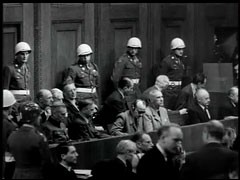
-
Liberation of Dachau
FilmThe Dachau concentration camp, northwest of Munich, Germany, was the first regular concentration camp the Nazis established in 1933. About twelve years later, on April 29, 1945, US armed forces liberated the camp. There were about 30,000 starving prisoners in the camp at the time. Here, soldiers of the US Seventh Army document conditions in the camp. They also require German civilians to tour the camp and confront Nazi atrocities.
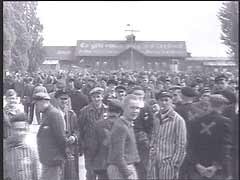
-
Aerial view of Dachau concentration camp
Film[This video is silent] The Dachau concentration camp, northwest of Munich, Germany, was the first regular concentration camp the Nazis established in 1933. About twelve years later, on April 29, 1945, US armed forces liberated the camp. There were some 30,000 starving prisoners in the camp at the time. This footage shows an aerial view of the camp and the entrance gate to the prisoner compound.
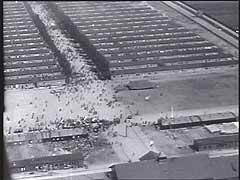
-
US soldiers care for Dachau survivors
FilmThe Dachau concentration camp, northwest of Munich, Germany, was the first regular concentration camp the Nazis established in 1933. About twelve years later, on April 29, 1945, US armed forces liberated the camp. There were some 30,000 starving prisoners in the camp at that time. In this footage, soldiers of the US Seventh Army feed and disinfect survivors of the camp.
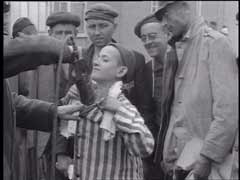
-
The courtroom during the Einsatzgruppen Trial
PhotoThe courtroom during the Einsatzgruppen Trial of the Subsequent Nuremberg Proceedings. Chief Prosecutor Benjamin Ferencz stands in the center of the room. He is presenting evidence. Nuremberg, Germany, between September 29, 1947, and April 10, 1948.
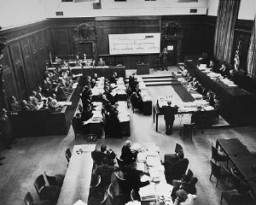
-
Interpreters at the International Military Tribunal
PhotoView of the interpreters' section in the courtroom during the International Military Tribunal. Nuremberg, Germany, March 29, 1946. The Nuremberg trials were an early experiment in simultaneous translation. The charter of the International Military Tribunal stated that the defendants had the right to a fair trial and that, accordingly, all proceedings be translated into a language that the defendants understood.

-
One of the railcars of the Dachau death train
PhotoCorpses lie in one of the open railcars of the Dachau death train. The Dachau death train consisted of nearly forty cars containing the bodies of between two and three thousand prisoners transported to Dachau in the last days of the war. Dachau, Germany, April 29, 1945. This image is among the commonly reproduced and distributed, and often extremely graphic, images of liberation. These photographs provided powerful documentation of the crimes of the Nazi era.
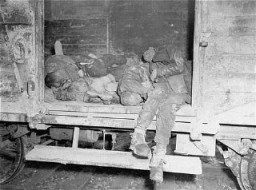
-
Bodies in the Dachau crematorium mortuary
PhotoThe bodies of former prisoners are piled in the crematorium mortuary in the newly liberated Dachau concentration camp. Dachau, Germany, April 29, 1945. This image is among the commonly reproduced and distributed, and often extremely graphic, images of liberation. These photographs provided powerful documentation of the crimes of the Nazi era.

-
Dachau death train
PhotoCorpses lie in one of the open railcars of the Dachau death train. The Dachau death train consisted of nearly forty cars containing the bodies of between two and three thousand prisoners transported to Dachau in the last days of the war. Dachau, Germany, April 29, 1945. This image is among the commonly reproduced and distributed, and often extremely graphic, images of liberation. These photographs provided powerful documentation of the crimes of the Nazi era.

-
Demonstrating the operation of the Dachau crematorium
PhotoSurvivors of the Dachau concentration camp demonstrate the operation of the crematorium by pushing a corpse into one of the ovens. Dachau, Germany, April 29–May 10, 1945. This image is among the commonly reproduced and distributed, and often extremely graphic, images of liberation. These photographs provided powerful documentation of the crimes of the Nazi era.
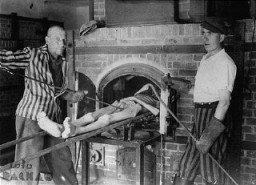
-
Demonstrating the operation of the Dachau crematorium
PhotoSurvivors of the Dachau concentration camp demonstrate the operation of the crematorium by pushing a corpse into one of the ovens. Dachau, Germany, April 29–May 10, 1945. This image is among the commonly reproduced and distributed, and often extremely graphic, images of liberation. These photographs provided powerful documentation of the crimes of the Nazi era.
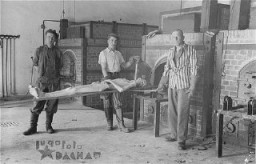
-
Demonstrating the operation of the Dachau crematorium
PhotoSurvivors of the Dachau concentration camp demonstrate the operation of the crematorium by preparing a corpse to be placed into one of the ovens. Dachau, Germany, April 29–May 10, 1945. This image is among the commonly reproduced and distributed, and often extremely graphic, images of liberation. These photographs provided powerful documentation of the crimes of the Nazi era.
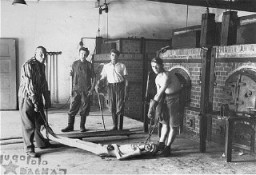
-
Demonstrating the operation of the Dachau crematorium
PhotoSurvivors of the Dachau concentration camp demonstrate the operation of the crematorium by dragging a corpse toward one of the ovens. Dachau, Germany, April 29–May 10, 1945. This image is among the commonly reproduced and distributed, and often extremely graphic, images of liberation. These photographs provided powerful documentation of the crimes of the Nazi era.
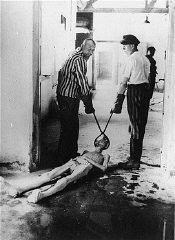
-
Demonstrating the cremation process at Dachau
PhotoSurvivors of the Dachau concentration camp prepare to move a corpse during a demonstration of the cremation process at the camp. Dachau, Germany, April 29–May 10, 1945. This image is among the commonly reproduced and distributed, and often extremely graphic, images of liberation. These photographs provided powerful documentation of the crimes of the Nazi era.
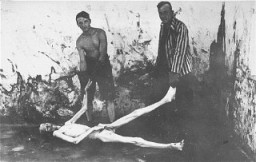
-
Babi Yar massacre
PhotoOn September 29-30, 1941, SS and German police units and their auxiliaries, under guidance of members of Einsatzgruppe C, murdered the Jewish population of Kiev at Babi Yar, a ravine northwest of the city. This photograph shows groups of Jews being forced to hand over their possessions and undress before being shot in the ravine.
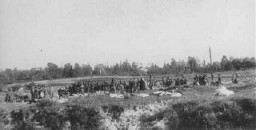
-
Aftermath of pogrom in Iasi
PhotoRoma (Gypsies) remove bodies from the Iasi-Calarasi death train during its stop in Tirgu-Frumos. Two trains left Iasi on June 30, 1941, bearing survivors of the pogrom that took place in Iasi on June 28-29. Hundreds of Jews died on the transports aboard crowded, unventilated freight cars in the heat of summer. Romania, July 1, 1941.
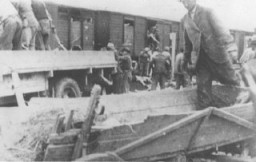
-
Breadline
PhotoThis photo of a Depression-era bread line was taken by Dorothea Lange at the White Angel Jungl...
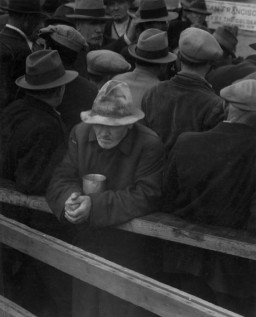
-
Two malnourished Soviet prisoners of war
PhotoTwo malnourished Soviet prisoners of war, survivors of the Hemer prisoner of war camp in western Germany. More than three million Soviet prisoners of war died in German custody, mostly from malnutrition and exposure. Hemer, Germany, April 29, 1945.
